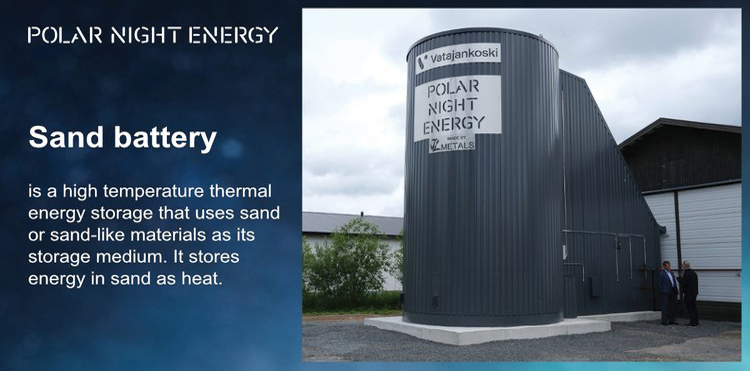By Mark S. Kuhar
A town in Finland is using sand batteries to provide home heating during winter. Sand batteries, you say?
Tens of thousands of cubic meters of sand are heated from the generation of electricity with solar panels or wind turbines. Packed tightly in insulated silos, the sand can retain this heat for months without losing it. For Finns living through a five-month long winter, it’s a vital load off the power grid.
The company behind this innovation, which can also use the heat to generate electricity as well as home heating, is called Polar Night Energy.

Here is a Q&A with Polar Night Energy.
What is a ‘Sand Battery’?
A “sand battery” is a high temperature thermal energy storage that uses sand or sand-like materials as its storage medium. It stores energy in sand as heat. Its main purpose is to work as a high-power and high-capacity reservoir for excess wind and solar energy. The energy is stored as heat, which can be used to heat homes, or to provide hot steam and high temperature process heat to industries that are often fossil-fuel dependent. As the world shifts toward higher and higher renewables fraction in electricity production, the intermittent nature of these energy sources cause challenges to energy networks. The sand battery helps to ambitiously upscale renewables production by ensuring there’s always a way to benefit from clean energy, even if the surplus is massive.
What is the structure of your heat storage?
It is an insulated silo made of steel housing, filled with sand and heat transfer pipes. Additionally, equipment outside the storage is required, such as automation components, valves, a fan and a heat exchanger or a steam generator.
How do you heat the sand?
With electricity from the grid or from local production, in both cases from fluctuating sources such as wind and solar. We charge it when clean and cheap electricity is available. The electrical energy is transferred to the heat storage using a closed loop air-pipe arrangement. Air is heated up using electrical resistors and circulated in the heat transfer piping.
How do you get heat out of the heat storage?
The heat storage is unloaded by blowing cool air through the pipes. It heats up as it passes through the storage, and it can be used for example to convert water into process steam or to heat district heating water in an air-to-water heat exchanger.
Why do you use sand?
Many solid materials, such as sand, can be heated to temperatures well above the boiling point of water. Sand-based heat storages can store several times the amount of energy that can be stored in a water tank of a similar size; this is thanks to the large temperature range allowed by the sand. So, it saves space and it allows versatile use in many industrial applications.
What kind of a sand you are using?
The heat storage is not very sensitive to sand grain size. We prefer high density, low-cost materials that are not from scarce sources. We prefer to use those grain sizes that are not suitable for the construction industry.
How is the heat storage insulated?
The heat storage is made of steel and insulated with standard, heat-resistant insulating materials. The insulation is all around the heat storage between the outer steel layer and the inner one.
How long does the sand stay hot in the winter?
It can stay hot for months if needed, but the actual use case of the heat storage in Kankaanpää is to charge it in about two-week cycles. The heat storage has its best range of use when it is charged and discharged 20 to 200 times per year, depending on the application.
Can it store electricity?
Not as such, as it stores energy in the form of heat. The heat can be converted back to electricity using turbines like the ORC-turbine or a steam turbine. This requires additional investments to the turbine technology, and the conversion to electricity has inherent losses, thus complicating the economical side.
For more information?
Polar Night Energy, www.pne.fi.
